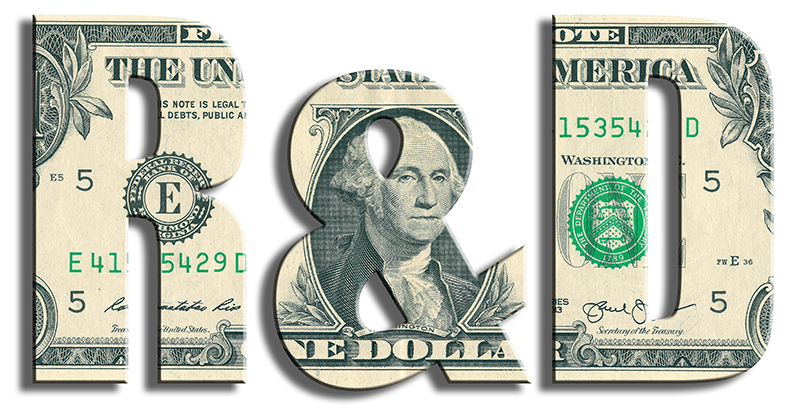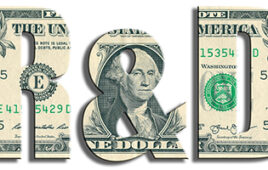
The R&D World Index (RDWI) for the week ending April 1, 2022, closed at 5,401.20 for the 25 companies in the RDWI. The Index was down -0.28% (or 15.28 basis points) from the week ending March 25, 2022. Sixteen of the 25 RDWI members gained value from 0.26% (Daimler AG) to 4.73% (Volkswagen AG). Nine of the 25 RDWI members lost value from -0.04% (Roche Holdings AG) to -7.18% (Intel).
HP Inc., Palo Alto, California, last week announced it was buying Poly, Santa Cruz, California, for $1.7 billion. The video-conferencing gear maker Poly was formed in 2018 by the combination of Plantronics and Polycom. HP, a manufacturer of personal computers and printers, was formed by the split of Hewlett-Packard in 2015. HP is betting that the current hybrid office/work-at-home environment created during the pandemic will continue and projects 15% annual growth for Poly’s revenue over the next three years. HP invested $1.9 billion in R&D in 2021 on revenues of $57 billion.
President Biden is considering invoking the Defense Production Act (DPA) to boost domestic production of the materials used in batteries that are used in electric vehicles (EVs). The DPA was created in 1950 at the beginning of the Korean War as part of President Truman’s national security mobilization efforts. The DPA could help companies to receive government funding for feasibility studies on projects that extract lithium, nickel, cobalt, graphite, and manganese used in EV battery production. The DPA could reduce U.S. reliance on other countries for these materials.
The U.S. Department of Commerce reported last week that the personal consumption expenditures (PCE) price index rose 6.4% in February from a year earlier and faster than the 6% rate reported for January. Federal Reserve chairman Jerome Powell noted that the inflation outlook has worsened significantly, even before Russia’s invasion of Ukraine. Most analysts are predicting the Fed will raise interest rates 0.5% at their next meeting on May 3-4, more than the 0.25% rate increase they made at their March 15-16 meeting. The European Union’s statistics agency last week reported that consumer prices were 7.5% higher in March than a year earlier, a jump from the 5.9% rate recorded in February for the EU. This was the fifth consecutive month that the inflation rate hit a new high in the EU. Economists report that the current rate of inflation in many European countries could be even higher. The European Central Bank (ECB) had been counting on a decline in energy prices to stabilize their inflation rate, but the Russia-Ukraine war has dashed those hopes. The U.S. inflation rate increase was also partially due to higher energy prices as well.
The U.S. Department of Defense (DOD) last week released its FY2023 budget request of $773 billion, up 4% from FY2022. DOD officials called the request a response to a “pacing” threat from China and a secondary “acute” threat from Russia — the request was formalized before Russia’s invasion of Ukraine. The watchdog Project of Government Oversight estimates that the U.S.’s annual budget is more than $1 trillion on national security. The DOD budget also has not considered the expected higher inflation rates expected in 2022 and 2023.
Semiconductor manufacturer, Nexperia, Nijmegen, Netherlands, announced last week that it is opening a new R&D design center in Richardson, Texas, its first in North America. Research at the Texas site will focus on analog design, power management and signal conditioning of integrated circuits. The company plans to expand its existing device portfolio with more complex and higher-power products. Nexperia was spun out of the Dutch NXP Semiconductor manufacturer in 2017. The company has more than 12,000 employees and was acquired by China’s Wingtech Technology in 2018 for $3.6 billion. Richardson was selected as the site due to the region’s “tremendous pool” of talent in the semiconductor industry, along with new talent and collaboration opportunities with universities in the area.
The Alliance for Automotive Innovation (AAI), Washington, D.C., last week petitioned the U.S. Court of Appeals to join the Environmental Protection Agency (EPA) to defend tougher automotive emissions standards against a legal challenge. The new EPA rules were established in December 2021 and set to take effect with the new car model year for 2023. Texas and 13 other states are challenging those rules in court. AAI is the top lobbying group for automakers and suppliers.
RDW Index member Volkswagen AG, Wolfsburg, Germany, announced last week that its supervisory board and labor leaders are reconsidering its globalization strategies. Following geopolitical tensions in China and Russia, VW board members and labor leaders are stating that the company should buttress the company’s fragile international supply chain and increase investment in core Europe and U.S. markets to dilute their dependence on Asian suppliers. Parts shortages have exposed weaknesses in focusing on cost-effective part suppliers.
Following sanctions on Russia over its invasion of Ukraine, Qatar is now emerging as a supplier of natural gas to Europe as the region weans itself from Russian supplies. Germany, France, Belgium, and Italy were in talks last week with liquefied natural gas (LNG) suppliers in Qatar. Qatar is in the midst of a $28.7 billion plan to boost its LNG production capacity by 40% or 33 million metric tons/year by 2026. That would more than offset all of Russia’s LNG exports to Europe.
Waymo LLC, Mountain View, California, which is owned by RDW Index member Google, reported last week that it is sending fully autonomous vehicles onto the streets of San Francisco. The rides are free and currently only available to Waymo employees. Waymo has been operating autonomous cars in suburban Phoenix, which is a much less challenging traffic environment. General Motors’ Cruise subsidiary has been offering free driverless rides to the public in San Francisco for the past two months but only from 10:30 p.m. to 5 a.m. local time. Cruise plans to expand those hours in the next several months. Six other companies have received permits from the State of California to test drive autonomous vehicles.
RDW Index member Sanofi SA, Paris, announced last week that it plans to have eight major drug submissions in 2022, and 20 more in the next three to five years in the fields of immunology, oncology, rare blood diseases, and vaccines. Sanofi’s immunology and inflammation pipeline currently has 15 products in development and their flagship medicines are growing rapidly in the number of patients treated.
R&D World’s R&D Index is a weekly stock market summary of the top international companies involved in R&D. The top 25 industrial R&D spenders in 2019 were selected based on the latest listings from Schonfeld & Associates’ June 2020 R&D Ratios & Budgets. These 25 companies include pharmaceutical (10 companies), automotive (6 companies) and ICT (9 companies) who invested a cumulative total of nearly 260 billion dollars in R&D in 2019, or approximately 10% of. Multri all the R&D spent in the world by government, industries and academia combined, according to R&D World’s 2021 Global R&D Funding Forecast. The stock prices used in the R&D World Index are tabulated from NASDAQ, NYSE, and OTC common stock prices for the companies selected at the close of stock trading business on the Friday preceding the online publication of the R&D World Index.



Tell Us What You Think!